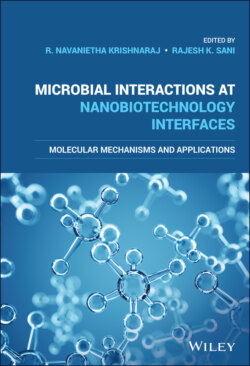Читать книгу Microbial Interactions at Nanobiotechnology Interfaces - Группа авторов - Страница 46
1.9 Antibacterial Mechanism of NMs
ОглавлениеNMs exert different mechanisms of action against microbes as represented in Figure 1.4. Most of the time, the antimicrobial systems employ multiple mechanisms to take over the multiple resistance mechanisms developed by microorganisms, thereby increasing the antimicrobial efficiency. In brief, different mechanisms of action of NMs are given below:
Figure 1.4 Schematic of the antibacterial mechanism of NMs.
Cell membrane disruption: Interaction of the NMs with the surface of the microbes causes mechanical damage to cell wall, which in turn leads to cell wall disruption followed by leakage of the cytoplasmic content and subsequent cell death (Pal, Tak, & Song, 2007).
DNA damage: NMs or metal ions from NMs diffuse through the cell wall and effectively interact with DNA and affect or modify the morphology of the DNA. This, in turn, interrupts the duplication or replication of DNA, leading to cell death (Feng et al., 2000).
Release of metal ions: Metal ions released from the NM diffuse into the cells and bind to thiol‐containing proteins including enzymes and compromise their function. In addition to that, metal ions generally function as cofactors for a number of enzymes. Hence homeostasis of metal ions is very important for the survival of the microorganism. Metal ions released from the NM diffuse in excess into bacterial cells, affecting the homeostasis leading to dysfunction of proteins and enzymes (Feng et al., 2000).
Interrupted transmembrane electron transport: Often the interaction of NM with cell wall damages the cell wall and hampers the electron transport chain leading to the disruption of cellular respiration and eventual cell death (Lemire, Harrison, & Turner, 2013).
Oxidative stress: Few of the NMs such as metals and metal oxides prominently induce production of ROS, which includes hydroxyl free radicals, superoxides, and hydrogen peroxide. The produced free radicals further oxidize cell wall components causing their disruption and act on the internal components of cells. In few cases, the oxidation continues till the entire cell is oxidized into CO2 and water. In some specific NMs such as carbon NMs, oxidative stress is induced without the involvement of ROS, which acts by electron transfer mechanism (Jacoby et al., 1998). Schematic of the antibacterial mechanism of NMs is given in the Figure 1.4 as described by Hajipour et al. (2012).
